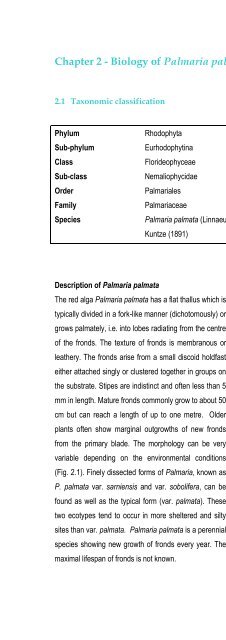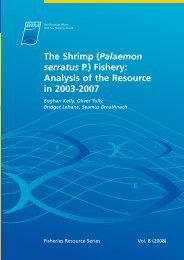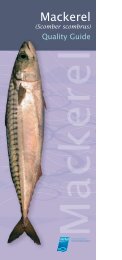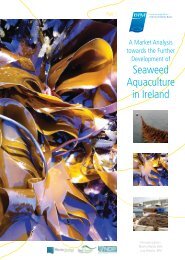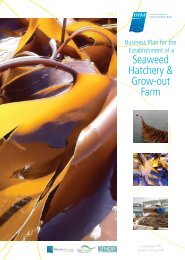Cultivating Palmaria palmata - Bord Iascaigh Mhara
Cultivating Palmaria palmata - Bord Iascaigh Mhara
Cultivating Palmaria palmata - Bord Iascaigh Mhara
Create successful ePaper yourself
Turn your PDF publications into a flip-book with our unique Google optimized e-Paper software.
Chapter 2 - Biology of <strong>Palmaria</strong> <strong>palmata</strong><br />
2.1 Taxonomic classification<br />
Phylum Rhodophyta<br />
Sub-phylum Eurhodophytina<br />
Class Florideophyceae<br />
Sub-class Nemaliophycidae<br />
Order <strong>Palmaria</strong>les<br />
Family <strong>Palmaria</strong>ceae<br />
Species <strong>Palmaria</strong> <strong>palmata</strong> (Linnaeus) O.<br />
Description of <strong>Palmaria</strong> <strong>palmata</strong><br />
Kuntze (1891)<br />
The red alga <strong>Palmaria</strong> <strong>palmata</strong> has a flat thallus which is<br />
typically divided in a fork-like manner (dichotomously) or<br />
grows palmately, i.e. into lobes radiating from the centre<br />
of the fronds. The texture of fronds is membranous or<br />
leathery. The fronds arise from a small discoid holdfast<br />
either attached singly or clustered together in groups on<br />
the substrate. Stipes are indistinct and often less than 5<br />
mm in length. Mature fronds commonly grow to about 50<br />
cm but can reach a length of up to one metre. Older<br />
plants often show marginal outgrowths of new fronds<br />
from the primary blade. The morphology can be very<br />
variable depending on the environmental conditions<br />
(Fig. 2.1). Finely dissected forms of <strong>Palmaria</strong>, known as<br />
P. <strong>palmata</strong> var. sarniensis and var. sobolifera, can be<br />
found as well as the typical form (var. <strong>palmata</strong>). These<br />
two ecotypes tend to occur in more sheltered and silty<br />
sites than var. <strong>palmata</strong>. <strong>Palmaria</strong> <strong>palmata</strong> is a perennial<br />
species showing new growth of fronds every year. The<br />
maximal lifespan of fronds is not known.<br />
Fig. 2.1. <strong>Palmaria</strong> <strong>palmata</strong>. A (middle): Habit of typical<br />
tetrasporophyte plant. B (right): Cross section through<br />
thallus of tetrasporangial plant. C (left): Morphology of<br />
ecotype <strong>Palmaria</strong> <strong>palmata</strong> var. sarniensis (from Irvine,<br />
1983).<br />
13


